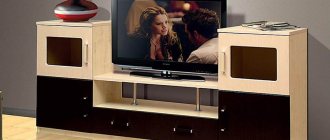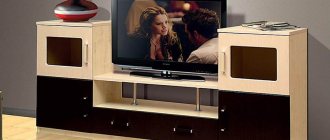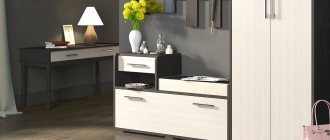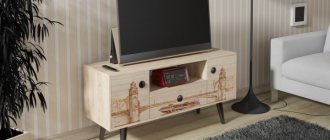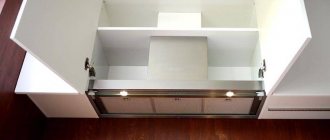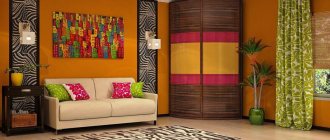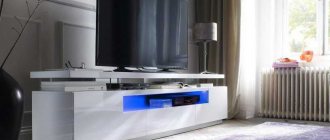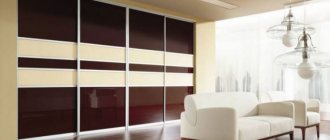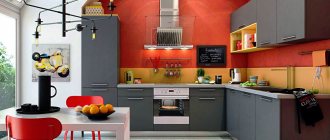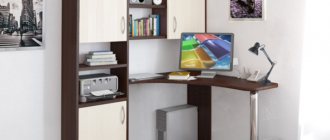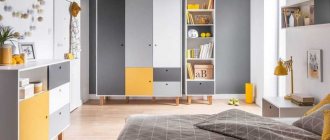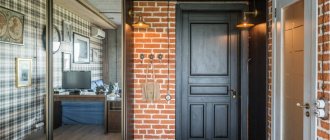<
>
Installing a TV stand in the living room is a fairly classic solution, provided for by most styles. This option will look equally organic in a spacious hall or a small room with a modest footage.
TV stand - advantages
Cabinets are fairly wide cabinets for storing things. However, they are not very tall. TV stands are no exception.
Installing such a piece of furniture provides a number of advantages:
- Pairs well with all types of modern TVs. At the same time, technology remains the dominant element. A correctly selected model will only emphasize its advantages;
- Effective use of footage. This is the most compact piece of furniture traditionally used for living rooms;
<
>
- A wide range of models in any style. You can equally well find a suitable option for a classic setting or with a focus on modern styles;
- Wide range of materials used, including the latest developments;
- Limitless possibilities in terms of decoration;
- A complete storage system with compact dimensions. An ideal solution for homeowners with modest dimensions.
TV stand frame - design, materials, coatings
The frame of a TV stand is the frame formed after the main parts are assembled. Comprises:
- Sidewalls (standard 2 pieces);
- The upper horizon, which can serve as a functional shelf for the cabinets;
- Lower horizon;
- Rear wall.
The quality and rigidity of the connection of all elements affects the stability of the furniture. Made from the following types of materials:
- Natural wood;
- Wood or particle boards (MDF, chipboard, fiberboard);
- Lacquered coated boards (chipboard, LMDF);
- Plastic;
- Thick tempered glass;
- Synthetic analogues of glass;
- Metals. Rarely used on their own. Most often they are combined with glass, mirrors, and wood.
Many materials require an additional protective layer. For these purposes the following is used:
- Painting with enamels;
- Multilayer varnishing;
- Polymerization (plastic coating);
- Lamination (thermally fixed film).
Materials for manufacturing TV stand frames
The frame of the product is formed by the sidewalls, the upper and lower horizons, and the back panel. In some models, the back has holes for wires, and some of the compartments are through. This avoids overheating of the equipment and simplifies its connection.
The materials used are: wood, wood boards, glass, metal, plastic.
- Natural wood is resistant to stress, highly decorative, environmentally safe, and durable. Its disadvantages are associated with significant cost, impressive weight, and the need for special care.
- MDF demonstrates decent performance, but is cheaper. Due to their dense structure, fiberboards are resistant to deformation, do not pose a danger to others, and have many options for exterior design.
- Chipboard is used in the production of budget furniture. However, structures made from particle boards are less resistant to loads, can sag under the weight of equipment, and emit formaldehyde.
- The glass undergoes special processing, acquiring the necessary strength. The material will delight you with a variety of designs: transparent, matte, colored, tinted, patterned. Glass furniture has the ability to visually unload a room, add light and volume. Disadvantages of this choice: increased susceptibility to contamination, sensitivity to shock.
- Metal combines well with different materials, which allows you to create products of interesting designs. All-metal cabinets are very rare, as they have an impressive weight and can be combined with a limited number of styles. Typically, metal is used to strengthen the frame, make supporting elements, and fittings.
- Plastic furniture stands out for its practicality, richness of colors, and unusual shapes. Its main disadvantage is its fragility, so such a design can only serve as a stand for a lightweight TV receiver.
The decorative coating depends on the material of the cabinet.
- The wood is painted or varnished.
- MDF is laminated, veneered, acrylic enamel is applied, and finished with PVC film or plastic.
- Laminate, film, and veneer are used for chipboard.
Shapes and sizes of modern TV stands
When choosing a TV stand, you should take into account the variety of their shapes:
- Geometrically correct. The most used type for floor cabinets;
- Round. Shelves can be elongated or semicircular. Most often, only the front side is rounded, and the back is shaped with an even cut. This makes it easier to position against a wall;
- Shelf type. The traditional case is practically absent. Sometimes all that remains is a narrow vertical bar at the back. Many open shelves are held together using corner posts. A characteristic type for glass structures;
- Complex bookcase. The shelves are not solid at all levels. Some tiers are made from 2 or 3 island shelves with smaller dimensions. In this case, additional steel stops are added;
- Asymmetrical multi-level. Several sections are held together by open long shelves. At the same time, they move sideways. Each section has its own body. A common type for mounted options.
For proper use with the ability to fit a TV stand into the interior, the following dimensions are important:
- Wide. These are considered models with a length of at least 1.2 meters. The largest models reach 3 meters in length. They differ in relatively small parameters in height and depth. Both of these values will fluctuate between 40 – 50 cm;
- Tall. The width starts from 80 cm and is limited to 120 cm. The optimal parameter for height is 85 – 90 cm. Depth rarely exceeds 50 cm;
- Narrow. This is a category from 60 to 80 cm. Using stands with a width of less than 60 cm is dangerous for the TV and the owner. They usually have a low depth parameter. It ranges from 35 to 45 cm. The height can be any, but the average becomes 80 cm;
- Low. This is a traditional option for hanging models. Their height can vary between 30 – 35 cm. The depth is about 40 cm. This is the minimum value. Cabinets with a shallower depth create a risk of the screen installed on it falling. Moreover, such models usually have considerable width (at least 1.4 meters).
Types of structures - suspended and floor models, their features
According to the method of placement, bedside tables are divided into two types.
- The hinged design makes the interior lighter and saves space. This model is modest in size and does not require frequent movement. It is mounted on a main wall using a strip and adjustable hinges, hinges, and brackets. It is important not to overload the product to avoid collapse.
- The floor-mounted TV stand is characterized by good stability and large capacity. It can be moved to another location if necessary. The base of the structure is made up of legs, a plinth, and wheels.
The legs raise the body above the floor surface and do not interfere with cleaning. Durable materials are used to make them: wood or metal. The supports are located vertically or at an angle, some can be adjusted in height. The latter property helps smooth out possible unevenness.
The plinth guarantees maximum stability. It is a separate platform or is a continuation of the sidewalls. However, over time, the interior space becomes a reservoir of dust and small debris.
Model with wheels is easy to move. You don't have to download all the content to do this. It is enough to remove the TV and other objects from the countertop. The best characteristics are provided by metal rollers with a soft rim and a rotating type. Their design must necessarily contain a device for fixing the selected position.
Varieties of designs according to placement method
There are the following types of installation of TV stands:
- Floor-standing. The bedside table is installed along the wall directly on the floor;
- Hanging. Creates the effect of “hovering” in the air. Attached to the wall.
The main element of support is the legs. The stability of the entire structure depends on their quality. May be as follows:
- Legs. 4 straight or curved supports attached to the outer corners of the body. All unevenness in the floor is responded to by shakyness and swaying of the furniture;
- Stops. Metal support elements located at an angle to the bottom of the housing. It looks as if the legs have sagged under the weight of the furniture. Very stable option with a high degree of reliability;
- Regulated. These are special screws with several wide, flat washers. By twisting them, the legs can be made of different heights. Very comfortable on uneven floors. Without screed repair work, the furniture will stand level. Not very beautiful in terms of design;
- Base system. Sidewalls extended by several cm act as legs. A transverse narrow strip is added along the front side - a plinth. Acts as a front stop. Allows you to cut corners on the sidewalls when fitting to the baseboard. The optimal width is 7 cm. Narrower bases will ripple when attached. Under it you can hide the not-so-pretty adjustable screws;
- Rollers. They are equipped with a protective decorative casing and a system of stops against arbitrary rolling. Significantly increase the mobility of long cabinets placed on the floor.
For wall-mounted TV stands, the quality of the fasteners comes first. Not so long ago, the choice was limited to several types of anchor bolts. Now in stores you can find up to a dozen types of special furniture canopies. They are distinguished by high resistance to loads. Can withstand at least 120 kg. Designed specifically for hanging the lower tiers of furniture sets. They consist of 2 plates, movably fastened using special bolts. Equipped with additional end caps. Fastened with 4 self-tapping screws. After installation, the cabinet can be moved up or forward by distances of up to 2 - 2.5 cm.
Canopies should always be installed in pairs along the edges. Installing one fastening in the center may result in damage to the furniture body due to improper load distribution. Wide cabinets will warp like scales. In very long versions (over 2 meters), additional fastenings are added in the center.
TV placement options
There are several ways to place the TV:
- Surface mounted. To do this, the screen must be equipped with a support leg. Ideally it should be rotating. This way you can adjust the angle of rotation;
- On the wall. For small screens, canopies or dowels are suitable. On durable brickwork, it is better to use steel options. For cinder blocks or foam blocks, purchase propylene dowels. But, for all TVs whose diagonal is equal to or exceeds 50 cm, special brackets are used. Many of them provide the ability to extend the screen forward, rotate it sideways, or even rotate it around its axis by 90° in both directions. Such options will of course cost more, but the ease of use and reliability will be at the proper level;
- Pantograph. In this case, the screen can also be moved in height with a significant spread. But, for this, the screen must have special side “handles” (recesses). Equipping with special holders (beam suspension) is also a prerequisite. Otherwise, the entire structure will lose the lion's share of reliability;
- In a niche. There will be difficulties in providing ventilation and cooling. There should be free space behind the screen. Due to overheating, not only plasma panels break prematurely. The LED screen in long overheating mode will respond to you with delamination. Any master can determine this. The TV will simply “fly out” of the warranty, and delaminated screens cannot be repaired.
On the back of the TV there are special places for mounting the bracket. Even TVs with legs have them. Standard bolts are screwed into them as standard. Only use them. Installing your own may result in a warranty denial. Also, the absence of a technician’s mark on mounting the screen on the bracket may cause the device to be excluded from warranty service.
Facades
All TV stands in the living room have several types of facade opening systems:
- Swing. The doors are attached with special hinges to the body. They open outward towards themselves. They will take up a lot of space. Reliable fastening method. Do not open the doors jerkily;
- Folding. The hinges are moved down the sash, and a pair of breakable side holders are added to the sides. When open, they also “eat up” enough space. Open down until the position lock clicks;
- Sliding. The doors are fastened with hinges in pairs. Moves sideways using the top roller. Folds like a book.
Pay maximum attention to decor:
- The widest variety of decorative glass. Matted, milky, patterned, bent. Richest choice;
- Mirrors. Can be colored or tinted. They will make the room visually wider and brighter;
- Hand painted. An original bright spot that will definitely attract attention;
- Photo printing. The design can be applied to all types of materials;
- Veneering. The material is expensive, capricious, but will give your furniture a luxurious appearance.
Color solution
Modern furniture is an important component of the style of a room, so when choosing, you should pay attention to many additional factors: weight, dimensions, design, and especially color schemes. If the interior of the room is dominated by a classic style, the best option would be a dark brown wooden TV stand. Any simple pattern or design on the surface will add color and diversify the overall design of the product.
Advantages of side tables, their features and varieties
Modern styles involve bright, rich colors. A black TV stand is always in demand; an unusual combination of shades or a play of several primary colors is trending. The unique “metallic” coloring, which allows you to create the effect of high cost and precision of lines, does not lose its relevance.
If the cabinet in the hallway is most often made in a restrained color, such as brown or gray, then models for the living room provide softer shades. Beige is always in demand, it “doesn’t hurt the eyes” and doesn’t make the furniture stand out from the rest of the interior.
When choosing TV furniture for the bedroom, you should give preference to soft, soothing shades. A good solution is dark brown; it will not be noticeable in a dim room even when the TV is on. For children's furniture, the choice of furniture color is unlimited; the range is represented by models from bright yellow to soft blue or pink. For teenagers, the “timeless classic” is suitable: dark blue or ivory.
Internal filling
A combination of open and closed straight shelves is considered classic for a cabinet. At the same time, drawers of various sizes can be added to the storage system. This cabinet is suitable for arranging decor, magazines, and books. The presence of glass sections for dishes or a mini bar will add not only functionality to the cabinet, but also style. Most models are equipped with through sections (without a back wall) for accompanying equipment or speakers.
Types of elements
Corner cabinets differ from ordinary rectilinear models in the shape of the back wall. There may be several options:
- the most common cabinet is triangular, it is stable, but is only suitable for small TVs;
- the trapezoidal cross-section allows for the placement of large-sized equipment, the free space at the back provides good ventilation;
- The L-shaped design takes up the least space;
- Curved, semicircular models look unusual.
A triangular-type cabinet should be small, otherwise the significant depth of the shelves will make the furniture inconvenient to use.
Triangular
Trapezoidal
L-shaped
Radial
Frame
When choosing a corner TV stand, first of all pay attention to the dimensions of the frame. Two gradations are used:
- By width. Maximum values of 1.2–1.5 m are optimal for a large living room. It is worth considering that such a cabinet will take up a lot of space. Another thing is narrow bedside tables; the usable space when placing them is wasted minimally. However, the width should not be less than 60 cm, otherwise the electronic device may fall.
- By height. Low corner TV stands are popular. Their height is up to 50 cm. Moreover, for ease of viewing, the equipment in such cases is placed on a stand or hung on the wall. 1.2 m is the optimal distance from the center of the screen to the floor; this point should be taken into account when choosing a corner cabinet with a TV stand.
It is recommended to first purchase a TV, and then select a stand in accordance with its parameters.
For a large living room, cabinets up to 1.2–1.5 meters long are suitable
For the convenience of watching TV, it is better to install equipment on a low stand on a stand
Facade
Depending on the style of the room and its size, you can choose an open or closed facade. Furniture with doors is convenient in its own way: behind them there are shelves on which you can place household items, hide not-so-aesthetic equipment wires, and so on. This design is more suitable for modern style. The doors can be glass - frosted or transparent, or they can be made of the same material as the frame.
Types of shoe cabinets, model features, useful additions
The open facade of the corner bedside table provides several shelves of the same or different heights. A TV is placed on the top one; on the rest you can put a video player, set-top box and other equipment connected to the TV.
On the shelves behind the doors you can place household items or hide not-so-aesthetic equipment wires
Open-front models usually have several shelves of the same or different heights
Opening system
If the selected TV stand includes doors, it is important to pay attention to the features of their opening. There are several options:
- The most convenient and common is the swing system. This cabinet has regular doors that open using handles.
- The folding system consists of a single flap, which is attached with hinges. To make the design more reliable, side holders are provided.
Benefits of long TV stands, placement tips
Some models are equipped with drawers. This design is convenient, but requires more free space to open them. In tall models of corner cabinets, a combined system is often used - drawers are combined with open and closed shelves, which adds functionality to the furniture.
Swing
With drawers
Decor
An important selection criterion is the original, attractive design of such furniture. So, a glass cabinet looks organic in a modern interior. Doors can be made of dark or frosted glass. Most often, such a surface is designed by sandblasting a pattern. Ideally, only the doors should be glass. With this design, the furniture will decorate the interior, but at the same time remain durable, reliable and as safe as possible from injury. An all-glass piece of furniture may not be able to withstand the weight of a large TV or children's pranks.
Cabinets are also decorated with veneer - narrow plates of wood. This product looks elegant and fits organically into classic interior styles. If desired, you can decorate it manually: paint the surface of the cabinet with acrylic paints and varnish the top. Such furniture would be appropriate in Provence and country styles.
The cabinet with a facade that imitates a fireplace looks beautiful.
With glass doors
With fireplace
Equipment
A stand designed for a TV, including a corner model, must be multifunctional. This becomes possible thanks to well-chosen equipment. Such furniture may include:
- sections for auxiliary equipment, they can be located under the TV, on the sides or even on shelves near it;
- narrow vertical shelves designed to accommodate magazines, remote controls, and decorative elements;
- built-in sockets and holes for wires;
- drawers, spacious compartments for linen and clothes;
- built-in minibar.
It is undesirable to install subwoofers and low-frequency speakers on the cabinet; their vibrations negatively affect the operation of the TV.
Sections for auxiliary equipment
Narrow vertical shelves and drawers
Additional equipment for television stands
Many TV stands are additionally equipped with:
- Turning platform. This is an oval overlay for the top panel. Almost identical in length. It is attached using a special semicircular element. It can tilt at different angles or rotate around its own axis. A good option for corner cabinets or TVs with a fixed leg;
- TV holder. This is a special rack equipped with a bracket with several degrees of freedom. The stand itself can also be height-adjustable. In this case, there is no problem with attaching the bracket to the wall;
- Backlight. Will give additional originality. It is quite easy to equip it yourself. The main thing is not to light up the TV screen.
Rules for selection and placement
In order for a corner TV stand to be easy to use and decorate the interior, you need not only to choose it correctly, but also to place it correctly. Recommendations from modern designers will help you cope with the task:
- The correct width of the furniture is important. It should be 35% larger than the size of the TV.
- When choosing a corner cabinet, you need to take into account the weight of the equipment that will be located on it.
- To make it comfortable to watch programs from a sofa located along the wall, it is better to purchase an electronic device that swivels on a leg.
- You need to place the corner TV stand away from the window, otherwise the screen may be overexposed during the day.
- To preserve vision, the distance from the screen to the eyes must be at least 2.5 m. It is believed that the exact value depends on the diagonal of the electronic device - you need to multiply this parameter by 3. Accordingly, a large TV should be placed at a distance of 3.5–4 m from sitting man.
- As for the height of the corner TV stand, the top of the screen should be at eye level with the viewers.
Requirements for an aquarium cabinet, criteria for its selection
According to statistics, corner TV stands are not very popular. It is believed that such placement of the TV is inconvenient, so they purchase such furniture only when the size of the room does not allow placing the equipment in another place. However, if you choose the right style and design of the bedside table, it can become a worthy interior decoration.
The width of the furniture should be 35% larger than the size of the TV
When choosing furniture, you need to take into account the weight of the equipment that will be placed on it
For the convenience of watching TV programs, it is better to purchase models with a swivel leg.
To prevent the screen from being overexposed, you need to place the corner cabinet away from the window
When watching TV, the distance from the screen to the eyes should be at least 2.5 meters
The top of the TV screen should be at eye level with the audience
Rules for placing a TV stand in the interior of a room
When choosing a place for a TV stand, you will have to focus on a number of the following requirements:
- The selected location should offer a high-quality view. No other tall furniture or partitions should be in view;
- No windows on the sides and opposite the screen. This is due to the fact that even modern screens will respond to direct sunlight with deterioration in image quality and color disturbance. Watching programs in overexposed conditions will quickly cause pain in the eyes;
- The screen must be hung at a distance from the floor of at least 1.2 m for living rooms and 1 m for bedrooms. Based on this, the height of the cabinet is selected. This problem disappears when you mount the TV to the wall. In any case, the upper third of the screen should be strictly at eye level of the person sitting opposite;
<
>
- An equally important condition is the distance to the TV. The easiest way to calculate this value yourself. Measure the screen diagonal. Then multiply the value by 3, or better yet, by 4. The resulting figure is the required meters. For example, a 42-inch diagonal requires the screen to be placed 2.4 m from the seat. This is for image quality with a resolution of 720. If the resolution is 1080, then you can reduce the footage to 1.7 m;
- A coffee table placed opposite the general stylistic direction will add additional charm to the atmosphere;
- Combined placement with two symmetrical side cabinets, display cases or narrow wall cabinets will give the wall a harmonious, complete look.
How to place a TV stand in the interior of a room
Most often, the TV stand is installed opposite the sofa group. It takes place against a free wall or in a corner. An island arrangement is possible in a spacious room.
In this case, a number of conditions must be met.
- The distance between the user and the TV should correspond to three screen diagonals.
- The cabinet should provide a comfortable height, which is approximately 1.5 m relative to the middle of the plasma panel.
- It is important to avoid direct sunlight on the screen. Installation next to a window opening would not be the best option. If it is not possible to choose another area, thick curtains should be used.
- Close proximity to any heating devices is undesirable.
- It is worth considering the connection to the power supply.
Styling options
It is very important when decorating the interior to choose the right style:
- Classic. If you're not very design-savvy, then this is just what the doctor ordered. Correct shapes, slightly rounded corners, straight silhouettes. It is almost impossible to spoil the overall appearance of this austere furniture. The decor is used strictly in moderation;
- Neo Baroque. A combination of pretentious palace styles with modern materials and technologies. The result is high-quality furniture with unusual rounded silhouettes;
- High tech. The futuristic and airy nature of the designs comes first. Lots of glass, chromed steel, bright plastic;
- Modern. Strict cubic shapes. Minimum decor and simplicity. Bright hues. Expensive and pretentious design is not used;
- Country styles. The common thread can be called country music. A large amount of natural wood with a minimum of processing. The decor is simple, as are the silhouettes. Direct, but very memorable style. Artificially aged furniture will do.
Photos in the interior
<
>
Despite the fact that TVs are increasingly “flying up” on the wall, the cabinet remains the most worthy frame for modern technology.
They fit harmoniously into any interior, helping to organize a complete storage system. Construction materials warehouse - plaster at wholesale prices.
